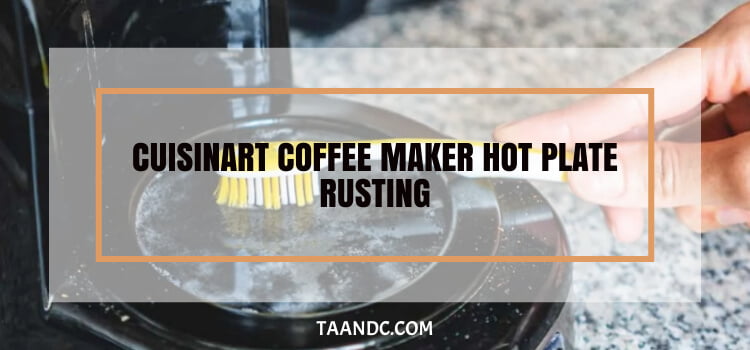Let's talk about Cuisinart Coffee Maker Hot Plate Rusting. As a coffee enthusiast, I've had my fair share of battles with this pesky issue. There's nothing worse than waking up to brew a fresh pot of coffee only to find rust stains tarnishing the hot plate. Over time, I've learned a few effective tricks to combat this problem. From diligent cleaning routines to exploring alternative protective measures, I've navigated through rust prevention with determination. Join me as I share my experiences and insights on keeping your Cuisinart coffee maker's hot plate rust-free for a delightful brewing experience every time.

Why Does Rusting Happen?
- Exposing the Hot Plate to Moisture: Rusting occurs when the hot plate of your Cuisinart coffee maker comes into contact with moisture. Any moisture left on the hot plate, whether from spilled water during brewing or leftover droplets after cleaning, can kickstart the rusting process. Water contains oxygen, and when it combines with the iron in the metal hot plate, it forms iron oxide, commonly known as rust.
- Impact of Oxidation on Metal Surfaces: Oxidation is a chemical reaction when metal is exposed to oxygen over time. The metal surface undergoes oxidation when the hot plate is exposed to air, especially in humid environments. This process weakens the metal structure, making it more prone to rust formation. Factors like scratches or dents on the hot plate can accelerate oxidation, providing more surface area for oxygen to react with the metal.
Read More: What Does Prog Mean On A Coffee Maker? The 'prog' Puzzle
The Dangers of Rusting
Rusting can pose several risks, especially affecting your Cuisinart coffee maker hot plate.
- Health Risks Associated with Rusty Hot Plates: When rust develops on the hot plate of your Cuisinart coffee maker, it can create health hazards. Tiny particles of rust may break off and mix with your brewed coffee, leading to ingestion. Consuming rust particles can cause stomach discomfort and potentially harm your health in the long term. Additionally, rusty hot plates can harbor bacteria and other harmful microorganisms, increasing the risk of foodborne illnesses.
- Effects on Coffee Taste and Quality: Rusting threatens your health and impacts your coffee's taste and quality. When rust particles mix with brewed coffee, they impart a metallic taste, altering the flavor profile and diminishing your coffee-drinking experience. Moreover, rust on the hot plate can disrupt the distribution of heat, leading to uneven extraction and affecting the overall taste of your coffee. Ensuring a rust-free hot plate is essential for maintaining your coffee's delicious flavor and quality.
Cleaning Your Cuisinart Coffee Maker Hot Plate
Keeping your Cuisinart coffee maker hot plate clean prevents rusting and ensures optimal performance.
- Safe Cleaning Methods: When cleaning your hot plate, it's important to use secure methods to avoid damaging the surface. Avoid harsh abrasive cleaners or scouring pads, as they can scratch the hot plate and make it more prone to rusting. Instead, use gentle cleaning methods that won't harm the metal surface.
- Using Mild Detergents and Soft Cloths: Choose mild detergents that are safe for use on metal surfaces. Mix a small detergent with warm water to create a gentle cleaning solution. Then, dampen a soft cloth with the solution and gently wipe the hot plate to remove any residue or buildup. Avoid using excessive force, as this can scratch the surface. Rinse the hot plate thoroughly with clean water and dry it completely with a soft, dry cloth to prevent moisture buildup, which can lead to rusting over time. Regular cleaning using these methods will help keep your hot plate in top condition and avoid rusting.
Read More: Is Instant Coffee Less Acidic? From Beans to Crystals
Preventive Measures
Taking proactive steps to prevent rusting on your Cuisinart coffee maker hot plate is key to longevity and performance.
- Drying the Hot Plate Thoroughly After Each Use: Ensure that the hot plate is dried thoroughly to prevent moisture buildup after brewing coffee. Use a clean, dry cloth to remove any water or coffee residue. Pay special attention to the crevices and edges where moisture tends to accumulate. By thoroughly drying the hot plate after each use, you can prevent the conditions that promote rust formation.
- Using Coasters or Mats to Protect the Hot Plate from Moisture: Placing coasters or mats under your coffee maker can provide an extra layer of protection against moisture. These barriers help to shield the hot plate from spills, condensation, and other sources of moisture that could lead to rusting. Choose coasters or mats made from waterproof materials that are easy to clean and maintain. By using these protective measures, you can minimize the risk of rusting and prolong the lifespan of your coffee maker's hot plate.
Regular Maintenance
Regular maintenance of your Cuisinart coffee maker hot plate prevents rust and ensures its continued functionality.
- Checking for Signs of Rust Regularly: Make it a habit to inspect your hot plate regularly for any signs of rust. Look for reddish-brown discoloration or rough patches on the surface, which indicate the presence of rust. Check all areas of the hot plate, including the edges and underneath, as rust can develop in hidden places. By conducting regular inspections, you can catch rust early on and take action to prevent it from spreading.
- Addressing Rust Spots Immediately: If you notice any rust spots during your inspection, it's crucial to address them promptly. Use a gentle cleaning solution and a soft cloth to remove the rust from the affected areas gently. If the rust is stubborn, use a mild abrasive like baking soda or a rust remover designed for metal surfaces. Once the rust is removed, thoroughly dry the hot plate to prevent further rust formation. By addressing rust spots immediately, you can prevent them from worsening and extend the lifespan of your coffee maker's hot plate.
Alternative Solutions
Exploring alternative solutions can protect your Cuisinart coffee maker hot plate against rusting.
- Protective Coatings: Consider applying a protective coating to the hot plate to create a barrier against moisture and oxidation. Various heat-resistant coatings are available specifically designed for metal surfaces like hot plates. These coatings form a durable layer that helps prevent rust formation and prolong the hot plate's lifespan. Follow the manufacturer's instructions when applying the coating to ensure optimal effectiveness.
- Using Stainless Steel Cleaners: Stainless steel cleaners can also effectively prevent rust and maintain the appearance of your hot plate. These cleaners are specially formulated to remove stains, fingerprints, and other residues while protecting against rust and corrosion. When using stainless steel cleaners, apply them according to the product instructions and use a soft cloth to buff the hot plate to a shiny finish gently. Using stainless steel cleaners can help keep your hot plate looking new and protect it from rusting.
Read More: How To Make Coffee In Cv1 Coffee Maker? Morning Magic
Seeking Professional Help
Sometimes, seeking professional assistance is necessary to effectively address rusting issues with your Cuisinart coffee maker hot plate.
- Contacting Cuisinart Customer Service: If you encounter persistent rusting problems with your coffee maker's hot plate, contacting Cuisinart's customer service can be helpful. They can provide guidance on troubleshooting steps, warranty coverage, and potential solutions for addressing the issue. Cuisinart's customer service representatives are knowledgeable about their products and can offer valuable insights and assistance tailored to your situation.
- Consulting with Appliance Repair Experts: If the rusting problem persists despite your efforts and Cuisinart's guidance, it may be time to consult with appliance repair experts. These professionals have the expertise and experience to diagnose and repair issues with coffee makers, including rusting hot plates. They can assess the extent of the rust damage, recommend appropriate repair or replacement options, and perform necessary maintenance precisely and efficiently. Consulting with appliance repair experts ensures that your coffee maker receives the professional attention it needs to function optimally.
FAQ
How do I clean the hot plate of my Cuisinart coffee maker?
Clean it with a soft cloth and mild detergent, and dry it thoroughly afterward.
Is it normal for my Cuisinart coffee maker’s hot plate to discolor over time?
Yes, discoloration can occur due to heat exposure, but regular cleaning can help maintain its appearance.
Can I use abrasive cleaners or scouring pads to clean the hot plate?
It’s not recommended as they can scratch the surface, making it more prone to rusting.
How often should I check for rust on the hot plate?
To catch rust early, it’s a good idea to check for rust regularly, ideally after each use.
What should I do if I notice rust on my Cuisinart coffee maker’s hot plate?
Address it promptly using a gentle cleaning solution and soft cloth, then ensure the hot plate is thoroughly dried to prevent further rusting.
Conclusion
Preventing rust on your Cuisinart coffee maker hot plate is crucial for longevity. Thoroughly drying the hot plate after each use and using coasters or mats to shield it from moisture are key preventive measures. Regular maintenance, such as checking for rust and addressing it promptly, is vital for preserving the hot plate's condition. Exploring alternatives like protective coatings and stainless steel cleaners can offer additional protection. Remember, seeking help from Cuisinart customer service or appliance repair experts can provide valuable assistance. Following these steps ensures your coffee maker stays rust-free and delivers delicious coffee for years.


